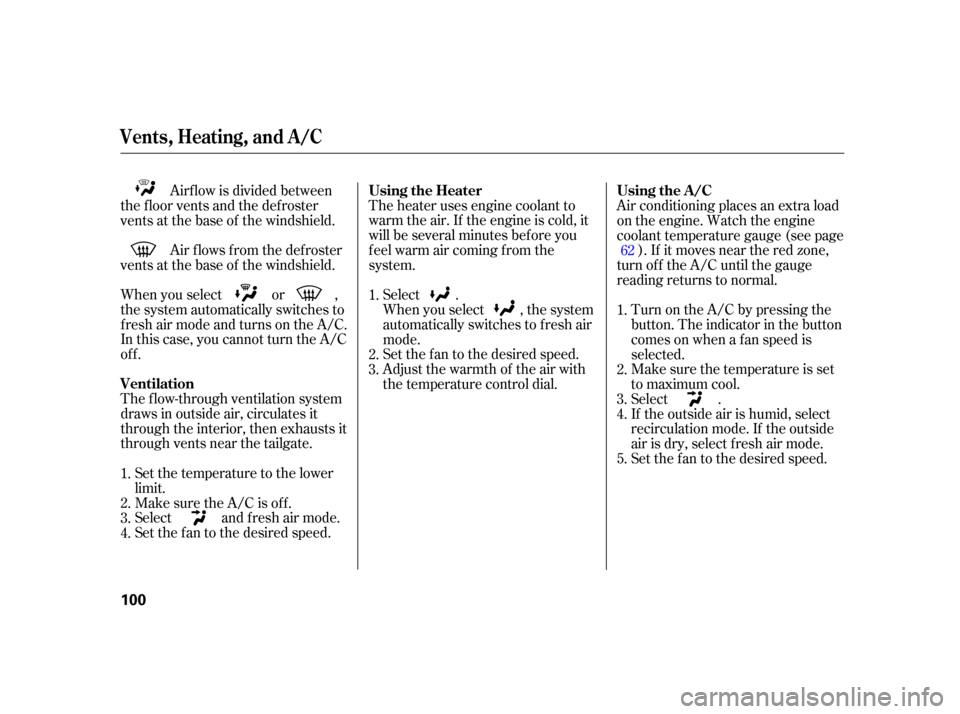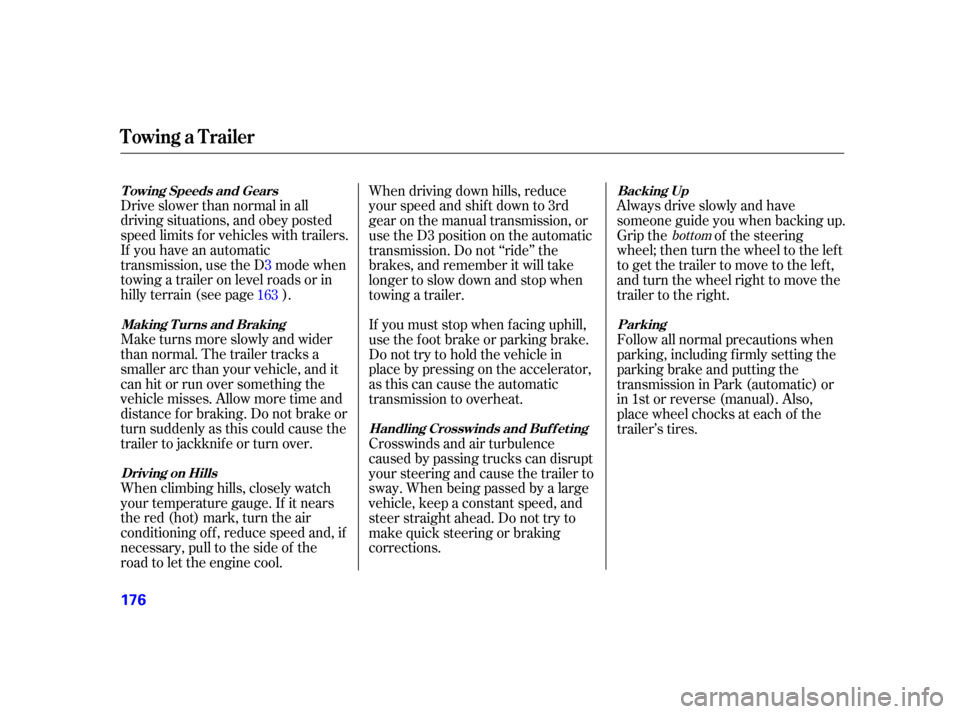Page 100 of 274

The heating and air conditioning
system in your vehicle provides a
comf ortable driving environment in
all weather conditions.
The standard audio system has
many f eatures. This section de-
scribes those f eatures and how to
use them.
Your vehicle has an anti-theft audio
system that requires a code number
to enable it................
Vents, Heating, and A/C . 98
................................
Audio System .103
...................
Playing the Radio . 105,116
..........................
Playing a Disc .109,124
..........................
Disc Changer .111,125
Disc Player/Changer Error .............................
Messages .112,128
.........................
Playing a Tape .113,129
Caring f or the Tape and ...................................
Player .115,131
.
Playing the XM
Satellite Radio . 120
............................
Radio Reception .132
..................
Protecting Your Discs . 134
................
Remote Audio Controls . 135
.................
Radio Thef t Protection . 136
..........................
Setting the Clock .137
...............................
Cruise Control .138
Features
Features
97
Page 101 of 274
Vents, Heating, and A/C
98
FAN CONTROL
DIALTEMPERATURE
CONTROL DIAL
MODE CONTROL
DIAL
RECIRCULATION
BUTTON AIR CONDITIONING
(A/C) BUTTON
REAR WINDOW DEFOGGER
BUTTONREAR WINDOW DEFOGGER/
HEATED MIRRORS BUTTON
(If equipped)
Page 102 of 274

The outside air intakes f or the
heating and cooling system are at
the base of the windshield. Keep this
area clear of leaves and other debris.
Thesystemshouldbeleftinfresh
air mode under almost all conditions.
Keeping the system in recirculation
mode, particularly with the A/C of f ,
can cause the windows to fog up.
Switch to recirculation mode when
driving through dusty or smoky
conditions, then return to fresh air
mode.
This button turns the rear window
def ogger of f and on (see page ).
When the recirculation indicator is
on, air f rom the vehicle’s interior is
sent throughout the system again.
When the indicator is off, air is
brought in f rom the outside of the
vehicle (fresh air mode). This button turns the air
conditioning on and of f . The
indicatorinthebuttonisonwhen
the A/C is on. Turning this dial clockwise increases
the temperature of the airflow. Turn this dial to increase or decrease
the fan speed and airflow. Use the mode control dial to select
the vents the air flows from. Some
air will f low f rom the dashboard
corner vents in all modes.
Air flows from the center
and corner vents in the dashboard.
Airf low is divided between
the vents in the dashboard and the
f loor vents.
Air f lows f rom the f loor
vents. When you select , the
system automatically switches to
f resh air mode.
On some models, this button also
controls the heated mirror function
(see page ). The system automatically
turns on the A/C and switches to
recirculation mode. Air f lows f rom
the center and side vents in the
dashboard.
68
89
CONT INUED
Rear Window Def ogger Button
Recirculation Button Air Conditioning (A/C) Button T emperature Control Dial
Fan Control Dial A ir Flow Buttons Mode Control Dial
Vents, Heating, and A/C
Features
99
Page 103 of 274

The heater uses engine coolant to
warm the air. If the engine is cold, it
will be several minutes bef ore you
f eel warm air coming f rom the
system.
The f low-through ventilation system
draws in outside air, circulates it
through the interior, then exhausts it
through vents near the tailgate. Air f lows f rom the def roster
vents at the base of the windshield. Airf low is divided between
the f loor vents and the def roster
vents at the base of the windshield.
When you select or ,
the system automatically switches to
f resh air mode and turns on the A/C.
In this case, you cannot turn the A/C
off.
Set the temperature to the lower
limit.
Make sure the A/C is of f .
Select and fresh air mode.
Set the f an to the desired speed. Select .
When you select , the system
automatically switches to f resh air
mode.
Set the f an to the desired speed.
Adjust the warmth of the air with
the temperature control dial.
Air conditioning places an extra load
on the engine. Watch the engine
coolant temperature gauge (see page
). If it moves near the red zone,
turn of f the A/C until the gauge
reading returns to normal.
Turn on the A/C by pressing the
button. The indicator in the button
comesonwhenafanspeedis
selected.
Make sure the temperature is set
to maximum cool.
Select .
If the outside air is humid, select
recirculation mode. If the outside
air is dry, select f resh air mode.
Set the f an to the desired speed.
1.
2.
3.
4. 1.
2.
3.
4.
5.
1.
2.
3.
62
Vents, Heating, and A/C
Using the Heater
Ventilation Using the A/C
100
Page 104 of 274

To remove f og f rom the inside of the
windows:
Air conditioning, as it cools, removes
moisture from the air. When used in
combination with the heater, it
makes the interior warm and dry.
This setting is suitable f or all driving
conditions whenever the outside
temperature is above 32°F (0°C).
To cool the interior with MAX A/C:
Set the f an to the desired speed.
Select MAX A/C mode.
The system automatically turns on
the A/C, selects , and
switches to recirculation mode.
Make sure the temperature is set
to maximum cool. you can
cool it down more rapidly by partially
opening the windows, turning on the
A/C, and setting the fan to
maximum speed in f resh air mode. Turn the fan on.
Turn on the air conditioning.
Select and fresh air mode.
Adjust the temperature to your
pref erence.
Set the f an to the desired speed or
high f or f aster def rosting.
Select . The system
automatically switches to fresh air
mode and turns on the A/C. The
A/C indicator will not come on, if
it was previously of f .
Adjust the temperature so the
airflow feels warm.
Select to help clear the
rear window and the outside
mirrors (if equipped).
To increase airf low to the
windshield, close the corner vents.
1.
2.
3.
4.
1.
2.
3.
4.
5.
1.
2.
3.
If the interior is very warm,
Vents, Heating, and A/C
To Def og and Def rost
To Dehumidify the Interior
Features
101
Page 150 of 274
Always maintain your vehicle
according to the maintenance
schedule. See(see page
).
an underinf lated tire
causes more ‘‘rolling resistance,’’
which uses more f uel.
The build-up of snow or mud on
your vehicle’s underside adds
weight and rolling resistance.
Frequent cleaning helps your f uel
mileage and reduces the chance of
corrosion.
Always drive in the highest gear
possible. The air conditioning puts an extra
load on the engine which makes it
usemorefuel.Usethefresh-air
ventilation when possible. Combine several short trips into
one. Try to maintain a constant speed.
Everytimeyouslowdownand
speed up, your vehicle uses extra
f uel. Use cruise control when
appropriate.
Drive moderately. Rapid
acceleration, abrupt cornering,
and hard braking use more f uel. 186
For example,
Fuel Economy
Improving Fuel Economy
Owner’s
Maintenance Checks
Bef ore Driving
147
Page 179 of 274

Drive slower than normal in all
driving situations, and obey posted
speed limits f or vehicles with trailers.
If you have an automatic
transmission, use the D3mode when
towing a trailer on level roads or in
hilly terrain (see page ).
Maketurnsmoreslowlyandwider
than normal. The trailer tracks a
smaller arc than your vehicle, and it
canhitorrunoversomethingthe
vehicle misses. Allow more time and
distance f or braking. Do not brake or
turn suddenly as this could cause the
trailer to jackknif e or turn over.
When climbing hills, closely watch
your temperature gauge. If it nears
the red (hot) mark, turn the air
conditioning of f , reduce speed and, if
necessary, pull to the side of the
road to let the engine cool. Always drive slowly and have
someone guide you when backing up.
Grip the of the steering
wheel; then turn the wheel to the lef t
to get the trailer to move to the left,
andturnthewheelrighttomovethe
trailer to the right.
If you must stop when f acing uphill,
use the f oot brake or parking brake.
Do not try to hold the vehicle in
placebypressingontheaccelerator,
as this can cause the automatic
transmission to overheat. When driving down hills, reduce
your speed and shif t down to 3rd
gear on the manual transmission, or
use the D3 position on the automatic
transmission. Do not ‘‘ride’’ the
brakes, and remember it will take
longer to slow down and stop when
towing a trailer.
Crosswinds and air turbulence
caused by passing trucks can disrupt
your steering and cause the trailer to
sway. When being passed by a large
vehicle, keep a constant speed, and
steer straight ahead. Do not try to
make quick steering or braking
corrections. Follow all normal precautions when
parking, including f irmly setting the
parking brake and putting the
transmission in Park (automatic) or
in 1st or reverse (manual). Also,
place wheel chocks at each of the
trailer’s tires.
163
bottom
T owing Speeds and Gears
Making T urns and Braking
Driving on Hills Handling Crosswinds and Buf f et ingBacking Up
Parking
Towing a Trailer
176
Page 250 of 274

�µ�µ�µ
�µ
�µ
�µ
�µ
�µ
�µ
�µ
�µ
�µ
�µ
�µ
�µ
�µ
�µ
Specif ications
Technical Inf ormation
247
Air Conditioning
Battery Fuses
Alignment
Tires
Lights
HFC-134a (R-134a)
17.0 18.7 oz (480 530 g) SP-10
12 V
12 V 55 W
21 W
36 AH/5 HR
12 V 12 V
12 V
12 V
12 V
12 V
12 V
12 V
12 V
21 W
3CP
8W
4CP
8W
5W
21 W
21/5 W
21 W
12 V 47 AH/20 HR 29 psi (200 kPa , 2.0 kgf/cm
)
29 psi (200 kPa , 2.0 kgf/cm)
1°45’
1°
0°
0.08 in (2.0 mm) 0.0in(0mm)
12 V
Refrigerant type
Charge quantity
Lubricant type
Capacity
Interior
Under-hood
Toe-in
Camber
Caster
Size
Pressure
215/65R16 98T
12 V 3 CP
Headlights
Front turn signal lights
Parking lights/side marker
lights
Rear turn signal lights
Stop/Taillights
Back-up lights
License plate light
Ceiling light
Spotlights
Cargo area Light
Rear side marker lights
High-mount brake light See page 240 or the fuse label
attached to the inside of the fuse
box door under the steering
column.
See page 241 or the fuse box
cover.
Front
Rear
Front
Rear
Front
Front/Rear
Front
Rear
High/Low
(H1)
(Amber)